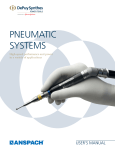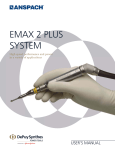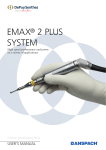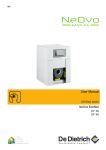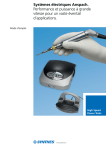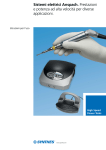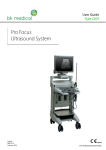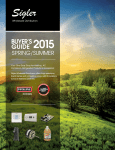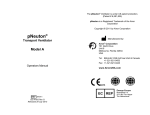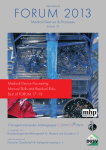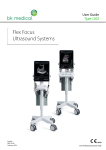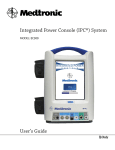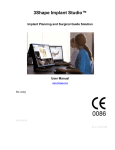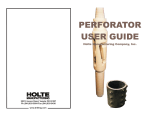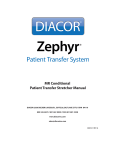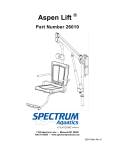Download Anspach Pneumatic Systems. High speed performance
Transcript
Anspach Pneumatic Systems. High speed performance and power in a variety of applications. User’s Manual High Speed Power Tools Table of Contents Introduction Operating Instructions Attachments and Dissection Tool Assembly Information Synthes Anspach 2 Pneumatic Instrument Systems 2 Indications 3 Warnings and Cautions 4 Technical Specifications 5 Glossary of Symbols 6 AutoLube III 7 Black Max 10 XMax and microMax 11 iMRI Instrument System 12 Straight Attachments and Dissection Tool Assembly For Black Max 15 For XMax and microMax 17 Minimal Access Attachments and Dissection Tool Assembly 23 Micro Curved Attachment 25 microSaws and Small Attachments Assembly 26 Handheld Attachments Assembly 29 Anspach Powered Irrigation System 32 Cleaning and Maintenance 34 Sterilization 37 Troubleshooting 38 Ordering Information 39 Warranty and Return Policies 41 Anspach Pneumatic Systems User’s Manual Synthes Anspach Pneumatic Systems. High speed performance and power in a variety of applications. Synthes Anspach Synthes Anspach manufactures pneumatic and electric high performance instruments and attachments to meet the specific needs of both surgeon and staff. While the advanced design of these instruments provides unparalleled performance and reliability, they also allow for effortless assembly, meeting the needs of both surgeon and staff for the most demanding applications. No tools are required to assemble dissection tools or attachments. All Synthes Anspach instruments are manufactured to conform to rigorous quality standards to provide dependable performance. Important: Before using any of the Synthes Anspach High Performance Systems, it is imperative that all individuals working with the system read this operating manual. The surgeon is responsible for learning the proper techniques in the use of this system, as improper use may cause injury. To schedule a hands-on training course, either at Synthes Anspach or from your local Synthes Anspach Sales Representative, call (800) 327-6887 or (561) 627-1080. If you have any questions after reading this manual, please call the Synthes Anspach Customer Service Department at (800) 327-6887 or (561) 627-1080. 2 Synthes Anspach Pneumatic Systems User’s Manual Pneumatic Instrument Systems The XMax® sets a new standard for the ultimate combination of high power, smooth operation, low noise level, and small size. This new level of performance provides the perfect pneumatic system to handle a complete range of surgical procedures ranging from power demanding applications to the most delicate dissection. With a minimum speed of 80,000 rpm at 120 psi (8.3 bar) input pressure, the XMax system is one of the quietest pneumatic handpieces available, with 35% more power than Black Max and 50% more than microMax Plus. The microMax Plus operates at 80,000 rpm. It is small and lightweight to minimize fatigue for long procedures. It has 60% more power than microMax. The Black Max, operating at 80,000 rpm at 120 psi (8.3 bar), offers smooth, controlled bone dissection. The iMRI Instrument System provides an Intraoperative MRI compatible configuration. The iMRI Instrument System utilizes non-magnetic materials in the handpiece, attachment, and dissection tool components that have been approved for use with field strengths up to 1.5 Tesla. Indications XMax Cutting and shaping bone Black Max Cutting and shaping bone microMax Cutting and shaping bone iMRI Surgical Drill System The Anspach iMRI Surgical Drill System (including pneumatic drill motor, foot control, nosepiece attachments and cutters), is indicated for intraoperative (non-imaging) use within a Magnetic Resonance Imaging (MRI) environment rated at 1.5 Tesla or less, for surgical cutting, shaping an iMRI removal of bone, including bones of the skull and spine. Spine surgery Neurosurgery and ENT Synthes 3 Warnings and Cautions United States Federal law restricts this device to sale by or on order of a physician or other licensed healthcare provider. Surgeon is responsible for learning proper techniques in use of equipment; improper use may cause serious injury to user or patient or damage to system. Instrument operator and all operating room personnel must wear eye protection. Visually inspect for damage before using; do not use if damage is evident. Do not use accessories other than those provided by Anspach and specified for use with Anspach systems. Use care to protect hose when handling, cleaning, and during system use. Do not operate handpiece without an attachment and the corresponding dissection tool. (i.e. Only use Black Max cutting burrs with Black Max attachments.) Use caution to avoid cutting or tearing gloves while handling dissection tools. Dissection tools must be adequately retained within attachment to prevent distal migration, which may cause injury. Confirm attachment is proper size for dissection tool and that it is secure. Gently pull on dissection tool shaft to ensure it is fully seated and properly installed. Do not engage safety mechanism while handpiece is running; doing so makes safety mechanism inoperable. Damage to hose can cause leaking, rupture, or other related failures. Only cut visible areas unless an image intensifier is utilized. Handpiece’s outer hose can rupture without warning if occluded. Delicate structures in proximity to dissection must be thoroughly protected to prevent injury. Do not step on, set equipment on, pinch, kink, clamp, or otherwise occlude handpiece hose during use. Irrigation is necessary for proper operation. Do not use if pressure relief valve has cracks or hose has cuts or abrasions. Do not use if the product sterilization barrier or its packaging is compromised. Do not use, or discontinue use of powered equipment exhibiting excessive temperatures that can cause patient injury (necrosis) and/or user discomfort. Use of damaged or improperly maintained power equipment and/or misused powered equipment can result in excessive temperatures. To ensure equipment operates as designed, read and follow manufacturer's instructions, including those for proper service and maintenance. 4 Synthes Anspach Pneumatic Systems User’s Manual Maintain firm control of instrument at all times. Do not bend or use as a lever. Use a gentle tapping motion or side-to-side motion and let instrument do cutting. Do not use excessive force. Forceful side loading of dissection tool may cause fracture of dissection tool, which may cause injury. Dissection tools are disposable and intended for single patient use only. Do not resterilize and/or reuse dissection tools. Use standard protocol for disposal of sharp instruments. Technical Specifications BM MM Black Max Specifications* Speed Handpiece, muffler, hose Outside housing (diameter) Length of housing Handpiece weight Handpiece, muffler, hose weight up to 80,000 rpm 3.81 m (12.5 ft) 19 mm (.75 in) 91 mm (3.6 in) 70 gms (2.6 oz) 0.65 kg (1.4 lbs) microMax Specifications Speed Handpiece, muffler, hose Outside housing (diameter) Length of housing Handpiece weight Handpiece, muffler, hose weight XM MM XMax Specifications Speed Handpiece, muffler, hose Outside housing (diameter) Length of housing Handpiece weight Handpiece, muffler, hose weight up to 80,000 rpm 3.81 m (12.5 ft) 17.4 mm (.685 in) 102.02 mm (4.025 in) 75.3 gms (2.7 oz) 0.65 kg (1.45 lbs) microMax Plus Specifications Speed Handpiece, muffler, hose Outside housing (diameter) Length of housing Handpiece weight Handpiece, muffler, hose weight The device complies with the following standards: IEC 60601-1 / IEC 60601-1-2 IEC 61000-3-2 / IEC 61000-3-3 / IEC 61000-4/2 / IEC 61000-4-4 / IEC 61000-4-5 / IEC 61000-4-11 / IEC 61000-4-8 / IEC 61000-4-6 / IEC 61000-4-3 With regard to electrical shock, fire, mechanical hazards, this device is certified to UL 60601-1 and CAN/CSA C22.2 No. 601.1 This device complies with applicable EEC directives. up to 80,000 rpm 3.81 m (12.5 ft) 15.8 mm (.625 in) 89 mm (3.5 in) 56.70 gms (2 oz) 0.5 kg (1.1 lbs) up to 80,000 rpm 3.81 m (12.5 ft) 15.8 mm (.625 in) 95.25 mm (3.75 in) 75.3 gms (2.7 oz) 0.65 kg (1.4 lbs) iMRI iMRI Handpiece Speed Handpiece and Hose Outside Housing (diameter) Length of Housing Handpiece and hose weight 10,000-75,000 rpm 3.81 m (12.5 ft) 17.5 mm (.69 in) 101 mm (4 in) 635 gms (1.41 lb) Patent Information Synthes Anspach products are manufactured under one or more of the following U.S. Patent Nos. RE 37,358; 5,405,348; 5,601,560; 5,630,818; 5,741,084; 5,904,687; 6,607,533; 6,733,218; 6,746,153; 6,749,341; 6,969,368; 7,128,544; 7,144,415; 7,217,090; 7,255,546; 7,261,526 and 7,458,979. Additional U.S. and International patents pending. Additional Information All specifications are subject to change. * The Synthes Anspach Black Max Instrument System is not sponsored by, endorsed by or otherwise associated with United States Manufacturing Corp. or its Blackmax prosthetic limbs. Synthes 5 Glossary of Symbols Reference Number (A.K.A. Item Number, Catalog Number, Part Number) CE Mark (A.K.A. CE Mark [notified body number], Conformité Européenne) Meaning: Device complies with applicable EEC Directives Lot (A.K.A. Lot Number, Batch Number, Batch Code MR Conditional. No known hazards at 1.5T. Serial Number 1.5T Lock (Run) 00/0000 Use By Date (A.K.A. Expiration Date, Expiry) Unlock (Load) Manufacturer Transmitter Interference may occur in the vicinity of equipment marked with this symbol. Authorized European Representative Sterile R (A.K.A. Sterilized Using Irradiation) Type B Electrical Equipment Single Use Only (A.K.A. Do Not Reuse) Attention (A.K.A. Caution, Warning, Danger, Important, Note, Refer to Accompanying Documentation) Instrument System Key BM Black Max MM microMax Plus XM XMax iMRI iMRI Keep Dry (A.K.A. Protect from Moisture) Sterile unless damaged or open United States Federal law restricts this device to sale by or on the order of a physician or other licensed health-care provider. 6 Synthes Anspach Pneumatic Systems User’s Manual Latex-free Certification There is no latex material in Synthes Anspach products or packaging. AutoLube III Operating Instructions For Black Max, XMax and microMax Assembly Procedures of AutoLube III and Handpiece 1 AUTOLUBE-III Foot Control For additional part numbers, refer to the "Components" section 1. Remove the red plug (installed for shipping only) from the recirculating bowl located on the top of the AutoLube III. 2. Turn the silver handle located on the back of the AutoLube III to the “OPEN” position. 3. While maintaining the handle in the “OPEN” position, insert the muffler end of the pneumatic handpiece into the cavity located on top of the recirculating bowl. 4. Insert the muffler until the red ring on the muffler cannot be seen. 5. Rotate silver handle to the “LOCK” position. Check for secure engagement. Operating Pressure Anspach pneumatic handpieces run on air or medical grade nitrogen. Standard operating pressure is 90-120 psi (8.3 bar). If more or less power is desired, the psi may be regulated between 40 and 140 psi. Oil Fill Cap Pressure Gauge Open Position 2 Silver Handle 3, 4 1. Connect the air hose from the AutoLube III to the hospital air source, nitrogen tank or hospital nitrogen system. 2. Adjust the air source until the desired air pressure registers on the gauge of the AutoLube III. Pressure will not register on the AutoLube III until the muffler is inserted and the foot pedal is activated. 3. The wall/nitrogen tank pressure may read as much as 40 psi higher than the AutoLube III gauge. Handpiece is fully functional at this time. Red Plug/ Recirculating Bowl Red Ring inserts fully into Recirculating Bowl Locked Position 5 Synthes 7 AutoLube III Operating Instructions Pressure Relief Valve Pressure Relief Valve Handpiece hose may include a pressure relief valve to remove excess pressure in the case of hose occlusion between the AutoLube and the valve. If the pressure relief valve is actuated during use, remove the source of the occlusion. Do not attempt to disassemble the pressure relief valve. AutoLube Lubrication OIL-II Instrument Oil with 1 Replacement Filter The AutoLube III has been delivered without oil or a filter installed. A bottle of Anspach lubricating oil, filter, and muffler have been shipped with the unit and must be added to the AutoLube III prior to use. 1. Before adding oil, disconnect the AutoLube III from the air source. 2. Remove Oil Fill Cap from the top of the AutoLube III and fill with Anspach lubricating instrument oil (OIL-II). Do not fill above the “Max Oil Level” line next to the oil reservoir. Always replace the oil fill cap securely. One full bottle of Anspach lubricating oil should be added when the oil level reaches the “MIN Oil Level” line etched next to the oil reservoir. Turn handle to open position to insert muffler Oil Fill Cap Oil Reservoir AutoLube Lubrication 1. 2. 4. 5. 3. Max. Oil Level Min. Oil Level 8 Synthes Anspach Pneumatic Systems User’s Manual 3. Before each use, a visual check of the oil reservoir should be made to ensure there will be an adequate supply of oil to circulate throughout the procedure. 4. Install filter and muffler following “Autolube-III Filter” section. AutoLube Filter Vented Cover Note: Always store and transport AutoLube III in an upright position. AutoLube III Filter FILTER-II AutoLube II & III Filters (5/pkg.) The filter, muffler filter, and vented cover have been packed separately in the AutoLube III box. The filters should be changed each time a bottle of Anspach lubricating oil is added. 1. Insert the filter by taking the tab and sliding the “horseshoe” shaped portion of the filter into the cavity in a downward motion. The tab will extend out of the cavity. 2. Push muffler filter into vented cover with the hole in muffler filter centered over the attachment screw. The muffler is oversized and must be compressed to fit. 3. Place the vented cover over the filter cavity and secure by turning the grey wingnut in a clockwise direction. Insert filter with a downward motion Filter Vented Cover Synthes 9 Black Max Operating Instructions The Black Max Handpiece BM BLACKMAX-N Swivel/Angle Motor Assembly BLACKMAX-O Fixed/Straight Motor Assembly BLACKMAX-N-LP Low Pressure Swivel/Angle Motor Assembly BLACKMAX-NS Neuro Safety BLACKMAX-NS-LP Low Pressure Neuro Safety Attachment Connection Lever Motor Housing/ Handpiece Operation Important: Firm control of the Black Max must be maintained at all times. Never force the dissection tool. Let the instrument do the cutting. Never use the attachments as a retractor to bend or pry. Release Cutter Lock Cutter Lever Only Anspach Black Max dissection tools should be used with the Black Max. Always use continuous irrigation to prevent heat build-up. Always wear safety glasses. Black Max Directional Features The words “SECURE” and “RELEASE” engraved on the side of the Black Max handpiece refer to the locking and unlocking the attachment onto the handpiece. The Lever, located on the top of the handpiece, is used to lock and unlock dissection tools within the handpiece. Caution: If the dissection tool is not inserted properly, the Lever will not secure the dissection tool. Do not force the Lever. For instructions on attachment assembly, refer to the specific instructions for each attachment in this manual. 10 Synthes Anspach Pneumatic Systems User’s Manual Black Max Handpiece Distal End XMax and microMax Operating Instructions The XMax and microMax Handpieces XM XMAX MICROMAX MICROMAX-LP MICROMAX-PLUS MICROMAX-PLUS-LP XMax Motor microMax Motor microMax Motor, Low Pressure microMax Plus Motor microMax Plus Motor, Low Pressure XMax Handpiece Distal End Handpiece Knurled Knob Directional Arrows Operation Important: Firm control of the handpiece must be maintained at all times. Never force the dissection tool. Let the instrument do the cutting. Never use the attachments as a retractor to bend or pry. Figure 1 Only Anspach XMax/microMax dissection tools should be used with the XMax and microMax. Always use continuous irrigation to prevent heat build-up. Always wear safety glasses. XM XMax Directional Arrows Notice the directional arrows and printing on the distal end of the handpiece housing: “RUN” ( ), “LOAD” ( ) and “SAFE.” These terms refer to locking and unlocking the attachment and dissection tool onto the handpiece (Figures 1 and 2). For instructions on attachment assembly, refer to the specific instructions for each attachment in this manual. Figure 2 microMax Handpiece Distal End MM microMax Directional Arrows Notice the directional arrows and printing on the side of the handpiece at the distal end: “SECURE” and “RELEASE.” These terms refer to locking and unlocking the attachment and dissection tool onto the handpiece (Figure 3). Handpiece Knurled Knob Directional Arrows Figure 3 Synthes 11 iMRI Instrument System iMRI Instrument System iMRI IMRI-MOTOR iMRI Motor IMRI-FOOT-CTRL iMRI Air Control IMRI-SHORT iMRI Short Attachment IMRI-SHORT-HD iMRI Short HD Attachment IMRI-CRANI-A iMRI Crani-A Attachment IMRI-OIL iMRI Synthetic Oil For additional components, refer to page 40. Use, Care and Operating Instructions Important: Do not use any attachments or cutters with iMRI handpiece not manufactured by Anspach, or not identified as “iMRI.” Do not operate handpiece without attachment and cutter installed. United States Federal law restricts this device to sale by or on order of a physician or other licensed health-care provider. Read and understand thoroughly before operating your new iMRI Instrument System. Failure to do so could lead to injury to you or your patient or cause severe damage to this equipment. The iMRI Instrument System is a design modification of the Anspach microMax System. Refer to the “XMax and microMax Operating Instructions” section for additional assembly instructions. iMRI System and cutters are constructed of materials that permit intraoperative use in an iMRI unit rated at 1.5 Tesla or less and only when iMRI is not being used for actual imaging purposes. Caution: Do not use in iMRI units rated at greater than 1.5 Tesla. Remove iMRI System from iMRI imaging volume during imaging. Failure to do so could result in unacceptable image noise and/or distortion. 12 Synthes Anspach Pneumatic Systems User’s Manual Testing of iMRI System as established by ASTM F2213-02 “Standard Test Method for Measurement of Magnetically Induced Torque on Passive Implants in Magnetic Resonance Environment” and F2052-02 “Standard Test Method for Measurement of Magnetically Induced Displacement Force on Medical Devices in Magnetic Resonance Environment” confirm there is no detectable magnetically induced torque on handpiece at 1.5 Tesla (when tested in a 1.5T magnet) and only slight deflection force (10° with 18% of force due to gravity) when subjected to a high field strength and high field gradient location (1.5 Tesla) when tested in a Siemens 1.5T Magnetom Symphony, Maestro Class Unit. iMRI System is designed for surgical procedures typically involving no more than 15 minutes of continuous (actively drilling) operation. If a procedure is expected to last longer, you should be aware handpiece speed and temperature may be affected. Normal speed of iMRI System will be less than microMax due to magnetic effects of iMRI and because iMRI System does not have continuous oiling. The lower speed will not adversely affect your ability to perform procedure and you will experience little to no magnetic pull on handpiece during use. However, the following effects may be noted: 1. Handpiece speed will slow when handpiece rotating mechanism is held 90° to magnetic field. 2. Handpiece temperature will increase when handpiece is held in 90° position for greater than 5 minutes. Handpiece should not become uncomfortably warm during normal use; procedures lasting greater than 15 minutes could cause handpiece temperature to rise. 3. Lock mechanisms of iMRI System and cutters are essentially the same as microMax. However, to help prevent unintended use of non-iMRI devices, geometry has been slightly modified to prohibit attachment of non-iMRI handpiece compatible devices. Important: Attempts to attach microMax components to iMRI handpiece could result in significant damage to iMRI Handpiece. Straight attachments should be used for no more than 10 procedures. Craniotome attachments should be used for no more than five procedures. Attachments are not repairable and should be replaced after the recommended number of uses. Metal component parts of iMRI handpiece and attachments, and all iMRI cutters are constructed of materials mostly unaffected by magnetic properties of iMRI. However, these materials have significantly less hardness, which directly affects durability. Proper use, cleaning, maintenance and preoperative inspection will help ensure safe use and prolong useful life of iMRI handpiece and attachments. Periodic routine servicing by Anspach is strongly recommended. iMRI cutters will dull more quickly than standard cutters because they are manufactured of nonmagnetic reactive material. Use with iMRI only. During surgical use, you should remain cognizant of cutter performance and have additional cutters available at all times. Continued use of dull cutters, in addition to possible necroses, may put additional stress on attachment and handpiece, leading to premature failure of those devices. Before each use, assemble system and test to ensure proper performance. Proper system performance is usually indicated when there is no unusual difficulty in attaching attachments and cutters, and when system operates at full speed (unloaded with cutter attached) with no unusual noise, vibration, wobble or whipping. Important: Carefully inspect handpiece and attachments postcleaning and again preoperatively to ensure there is no corrosion or remaining debris which could adversely affect operation or lead to attachment bearing failure during use. Continued use of damaged or worn handpiece or attachments can lead to bearing (or other) failures, which can result in foreign debris entering surgical wound site. Never reprocess or reuse iMRI cutters. iMRI cutters must be properly disposed of after single use. Synthes 13 iMRI Instrument System iMRI Operating Instructions Warning: Do not run handpiece without cutter and attachment installed. 1. Foot control must be placed on floor within reach of surgeon. Foot control is not subject to sterilization so should never be placed such that sterile field is compromised. 2. Place three (3) drops of iMRI OIL into muffler end of iMRI handpiece hose assembly. Do not exceed three (3) drops. Important: iMRI OIL is for use with iMRI Handpiece only. Do not use with other Anspach “Autolube” systems. iMRI OIL used in AutoLube can damage the sight window, resulting in oil leakage. 3. Connect muffler end of hose to foot control and inspect handpiece to ensure it is “iMRI” and that internal aspect of handpiece is free of damage or debris. Caution: Do not run handpiece without cutter and attachment installed. Damage to handpiece may result if handpiece is operated without cutter and attachment installed. 4. Select appropriate attachment. Inspect for any signs of corrosion or damage and ensure it is “iMRI.” Attach attachment to handpiece and turn clockwise to lock onto handpiece. Verify locking by pulling on attachment. 5. Select appropriate cutter and following all established sterile techniques, remove it from its packaging, insert it into and through attachment, into handpiece and lock into place. Verify locking by pulling on cutter. If using craniotome, cutter should be put into handpiece first, then put craniotome over cutter. 6. Attach iMRI foot control to air (or nitrogen) supply. Fully depress foot pedal and adjust supply air pressure such that gauge on foot control indicates 120 psi. 14 Synthes Anspach Pneumatic Systems User’s Manual 7. With handpiece in iMRI field but away from patient, fully depress foot control and assess handpiece for noise, vibration, wobble, and whipping. If assembly was without difficulty and handpiece sounds and feels right, initiate or continue with use. 8. During procedure, continuously assess cutting effectiveness. Though iMRI cutters are designed to cut effectively, they are constructed of a much softer metal than standard (non-iMRI) Anspach cutters which you may be accustomed to. Because of material softness, iMRI cutters will dull more quickly. If you notice a reduction in cutting effectiveness, stop and replace cutter. Warnings: Do not reprocess or use reprocessed cutters. iMRI cutters are constructed of stainless steel that is subject to dulling and possible distortion during initial use. Reprocessors may not be able to reprocess cutters to their original design condition and reuse could result in excessive whipping or vibration that could cause severe patient injury including death. Reprocessed cutters may also be duller than new cutters, resulting in less effective use and possible overheating causing necrosis of tissues and/or surgeon discomfort. Continued use of dull cutters can cause user to apply greater pressure while cutting, which can seriously damage attachment, and possible bearing failure. Bearing failure can result in foreign debris entering surgical wound site. iMRI craniotome is constructed of a softer metal than a non-iMRI craniotome and excessively applied force will cause craniotome leg/foot to bend or fracture. Do not bend attachment or use craniotome as a lever. Do not force cutter. Forceful side load may cause cutter fracture, which could cause injury. It can also result in handpiece speed reduction and increased temperature. 9. During surgical procedure, when iMRI is used for actual imaging, remove iMRI System and Cutters from imaging volume. Black Max Standard Attachments and Dissection Tool Assembly Black Max Dissection Tool Identification All dissection tools are packaged sterile, unless otherwise indicated, and are manufactured for single use. Each dissection tool has a series of identification numbers and letters imprinted on the label and on the shaft. The first group of letters and numbers designate the part number, the second group of letters and numbers designate the lot number. Each attachment is laser-marked with its corresponding part number. The first group of upper case letters of the dissection tool part number correspond to the attachment’s color-coded ring and/or name and the last digit represents the dissection tool style. Black Max Straight Attachments Refer to “Components” section for part numbers. 1. Lift Lever on handpiece. Align notch on attachment with “RELEASE” on side of Black Max handpiece. Turn attachment so notch is aligned with word “SECURE.” 2. Insert dissection tool into attachment. Return Lever on Black Max handpiece to down position. 3. Pull dissection tool to ensure proper engagement. 4. Adjust air source until desired air pressure registers on AutoLube gauge. Note: Air pressure will not register until foot pedal is depressed. B-SILVER Handpiece is now fully functional. The Operating pressure is 120 psi (8.3 bar), as indicated on the AutoLube gauge, when using these attachments, except for those specified in “Assembly Procedures of AutoLube III” section. For example: Black Max Dissection Tool Part Number: SIL-8 Dissection Tool Description: #8 style dissection tool used with the B-SILVER attachment. B-TURQUOISE B-VIOLET B-BLUE-S B-MRA-S, B-MRA-M, B-MRA-L B-TURQ-L B-GREY-MIA16 B-GREY-MIA20 B-BLACK B-RED Figure 1: Distal end of handpiece or attachment is pointed away Black Max Contra and Right Angle Attachments B-ORANGE-45 Contra Angle Attachment (Multiple Angle) B-ORANGE-90 Right Angle Attachment (90°) 1. Lift Lever on handpiece. Align notch on attachment with “RELEASE” on side of Black Max handpiece. Turn attachment so notch is aligned with word “SECURE.” 2. Push latch on the distal end of the attachment up with your thumb. 3. Insert dissection tool into the side of the distal end (opposite side of latch) while rotating slowly until dissection tool seats. 4. Release latch and check security of attachment by pulling it away from handpiece and check dissection tool by pulling on dissection tool head. Latch will be flush with attachment when dissection tool is secure. B-ORANGE-90 B-ORANGE-45 Figure 2: Distal end of handpiece or attachment is pointed away Handpiece is now fully functional. Synthes 15 Black Max Standard Attachments and Dissection Tool Assembly Black Max Craniotome and Specialty Attachments Refer to “Components” section for part numbers. 1. Lift Lever on Black Max. Insert dissection tool into handpiece. Return Lever to down position. Pull dissection tool to ensure proper engagement. 2. Slide attachment over dissection tool. Align notch on attachment with word “RELEASE” on the Black Max. Next turn attachment so notch is aligned with word “SECURE.” 3. The handpiece is now operational. Operating pressure is 120 psi (8.3 bar), as indicated on the AutoLube gauge, when using these attachments. B-TURQ-X B-GOLD B-GREEN B-GREEN-R B-GREY-ADG B-TURQ-CDA Figure 3 Black Max QD Angle Attachments B-QD8 Refer to “Components” section for part numbers. 1. Lift Lever on Black Max. Align notch on angle attachment with word “RELEASE” on the side of the Black Max. Next, turn angle attachment so notch is aligned with word “SECURE” which is laser etched on the side of the Black Max. 2. Pull down retaining sleeve on angle attachment and rotate to left when attachment is pointed away from you. B-QD11 B-QD14 3. Insert dissection tool. 4. Release retaining sleeve by rotating to left. 5. Pull dissection tool to ensure proper engagement. 6. Return Lever on Black Max handpiece to down position. Handpiece is now fully functional. Operating pressure is 120 psi (8.3 bar), as indicated on the AutoLube gauge, when using these attachments. 16 Synthes Anspach Pneumatic Systems User’s Manual Figure 4 XMax and microMax Standard Attachments and Dissection Tool Assembly Straight Attachment Assembly Motor Housing/Handpiece (XMax, microMax) Retaining Sleeve Straight Attachment Dissection Tool Craniotome Attachment Assembly Motor Housing/Handpiece (XMax, microMax) Retaining Sleeve Dissection Tool Craniotome Attachment Dissection Tool Identification All dissection tools are packaged sterile, unless otherwise indicated, and are manufactured for single use. Each dissection tool has a series of identification numbers and letters imprinted on the label and on the shaft. The first letter describes the type of attachment, and the following characters indicate the size and style of the dissection tool. For example: Dissection Tool Part Number: S-2B Dissection Tool Description: 2 mm Fluted Ball for Short attachment Each attachment is laser-marked with its corresponding part number. Synthes 17 XMax and microMax Standard Attachments and Dissection Tool Assembly Straight Attachments SHORT MEDIUM LONG MIA16 SHORT-HD MEDIUM-HD LONG-HD XL-HD 5 cm Short Attachment 8 cm Medium Attachment 11 cm Long Attachment 16 cm Minimally Invasive Attachment 5 cm Heavy Duty Short Attachment 8 cm Heavy Duty Medium Attachment 12.4 cm Heavy Duty Long Attachment 20.2 cm Heavy Duty Extra Long Attachment MM SHORT MEDIUM LONG MIA16 SHORT-HD MEDIUM-HD Assembly for handpieces with “SECURE” and “RELEASE” 1. Move handpiece knurled knob to “SECURE” position. 2. Slide attachment over distal end of handpiece housing, push down and rotate attachment to right approximately one quarter turn until fully seated. 3. Pull down on handpiece knurled knob and insert dissection tool into distal end of attachment. Rotate dissection tool slowly until dissection tool seats. 4. Release handpiece knurled knob to “SECURE” position. Handpiece is now fully functional. 5. Check security of dissection tool by pulling on dissection tool shaft. 6. Attachment and dissection tool are secure. Disassembly 1. Move handpiece knurled knob to “RELEASE” position. 2. Remove dissection tool from distal end of attachment. 3. Rotate attachment to left approximately one quarter turn and remove from distal end of handpiece. LONG-HD XL-HD XM Assembly for handpieces with and . (Distal end of handpiece or attachment is pointed away from user.) 1. Move handpiece knurled knob to “RUN” ( ) position. 2. Slide attachment over distal end of handpiece. Pull attachment towards handpiece, and rotate attachment to right approximately one quarter turn until fully seated. Handpiece knurled knob moves up to seat next to attachment. 3. Pull handpiece knurled knob towards “LOAD” ( ) position and insert dissection tool into distal end of attachment. Rotate dissection tool slowly until fully seated. 4. Release handpiece knurled knob into “RUN” ( ) position. Handpiece is now fully functional. 5. Pull dissection tool to ensure proper engagement. 6. Attachment and dissection tool are secure. Disassembly 1. Move handpiece knurled knob to “SAFE” position. 2. Remove dissection tool from distal end of attachment. 3. Rotate attachment to left approximately one quarter turn, and remove from distal end of handpiece. 18 Synthes Anspach Pneumatic Systems User’s Manual Orange 45° or 90° Contra Angle Attachments ORANGE-45 ORANGE-90 ORANGE-45 45° Contra Angle Attachment 90° Contra Angle Attachment ORANGE-90 Set AutoLube operating pressure to 40 psi (2.8 bar). MM Assembly for handpieces with and . 1. Ensure knurled knob on handpiece is in “RUN” ( ) position. 2. Slide attachment over distal end of handpiece. Push attachment towards handpiece, and rotate attachment clockwise until fully seated. Handpiece knurled knob moves up to seat next to attachment. 3. Push latch on the distal end of the attachment up with your thumb. 4. Insert dissection tool into the side of the distal end (opposite side of latch) while rotating slowly until dissection tool seats. 5. Release latch and check security of attachment by pulling it away from handpiece and check dissection tool by pulling on dissection tool head. Latch will be flush with attachment when dissection tool is secure. Handpiece is now fully functional. Disassembly 1. Lift latch on the distal end of the attachment with your thumb. Remove dissection tool and release latch. 2. Move handpiece knurled knob to “SAFE” position. 3. Rotate attachment counterclockwise and remove from distal end of handpiece. XM Assembly for handpieces with and . 1. Ensure knurled knob on handpiece is in “RUN” ( ) position. 2. Slide attachment over distal end of handpiece. Push attachment towards handpiece, and rotate attachment clockwise until fully seated. Handpiece knurled knob moves up to seat next to attachment. 3. Push latch on the distal end of the attachment up with your thumb. 4. Insert dissection tool into the side of the distal end (opposite side of latch) while rotating slowly until dissection tool seats. 5. Release latch and check security of attachment by pulling it away from handpiece and check dissection tool by pulling on dissection tool head. Latch will be flush with attachment when dissection tool is secure. Handpiece is now fully functional. Disassembly 1. Lift latch on the distal end of the attachment with your thumb. Remove dissection tool and release latch. 2. Move handpiece knurled knob to “SAFE” position. 3. Rotate attachment counterclockwise and remove from distal end of handpiece. Synthes 19 XMax and microMax Standard Attachments and Dissection Tool Assembly Craniotome and Specialty Attachments CRANI-P CRANI-A CRANI-L CRANI-A-R ADG CDA 6.5 cm Pediatric Craniotome 6.5 cm Adult Craniotome 14 cm Large Craniotome 6.5 cm Rotating Adult Craniotome 7.2 cm Adjustable Drill Guide 6.8 cm Controlled Depth Attachment MM CRANI-P CRANI-A CRANI-L CRANI-A-R Assembly for handpieces with “SECURE” and “RELEASE” 1. Pull down on handpiece knurled knob and insert dissection tool into distal end of handpiece. Rotate dissection tool slowly until dissection tool seats. 2. Release handpiece knurled knob into “SECURE” position. ADG CDA Handpiece is now fully functional. 3. Check security of dissection tool by pulling on dissection tool shaft. 4. Slide attachment over dissection tool and distal end of handpiece, push down and rotate attachment to right approximately one quarter turn until fully seated. 5. Attachment and dissection tool are secure. Disassembly 1. Move handpiece knurled knob to “RELEASE” position. 2. Rotate attachment to left approximately one quarter turn and remove from distal end of handpiece. 3. Remove dissection tool from distal end of handpiece. XM Assembly for handpieces with and . (Distal end of handpiece or attachment is pointed away from user.) 1. Pull handpiece knurled knob towards “LOAD” ( ) position and insert dissection tool into distal end of handpiece. Rotate dissection tool slowly until dissection tool is fully seated. 2. Release handpiece knurled knob into “RUN” ( ) position. Handpiece is now fully functional. 3. Pull dissection tool to ensure proper engagement. 4. Slide attachment over distal end of handpiece. Pull attachment towards handpiece, and rotate attachment to right approximately one quarter turn until fully seated. Handpiece knurled knob moves up to seat next to attachment. 5. Attachment and dissection tool are secure. Disassembly 1. Move handpiece knurled knob to “SAFE” position. 2. Rotate attachment to left approximately one quarter turn, and remove from distal end of handpiece. 3. Remove dissection tool from distal end of attachment. 20 Synthes Anspach Pneumatic Systems User’s Manual QD Angle Attachments QD8 8 cm Quick Disconnect Angle Attachment QD11 11 cm Quick Disconnect Angle Attachment QD14 14 cm Quick Disconnect Angle Attachment QD8 QD11 MM Assembly for handpieces with “SECURE” and “RELEASE” 1. Pull down handpiece knurled knob and slide angle attachment over distal end of handpiece until fully seated. Rotate attachment to right approximately one quarter turn. 2. Release handpiece knurled knob to “SECURE” position. 3. Pull down retaining sleeve on angle attachment and rotate to left. 4. Insert dissection tool into angle attachment. Rotate dissection tool slowly until dissection tool seats. 5. Release retaining sleeve on angle attachment by rotating retaining sleeve to right. Handpiece is now fully functional. 6. Check security of dissection tool by pulling on dissection tool shaft. Disassembly 1. Pull down on retaining sleeve on angle attachment and rotate to left. 2. Remove dissection tool from distal end of attachment. 3. Move handpiece knurled knob to “RELEASE” position. 4. Rotate attachment to left approximately one quarter turn and remove from distal end of handpiece. QD14 XM Assembly for handpieces with and . (Distal end of handpiece or attachment is pointed away from user.) 1. Move handpiece knurled knob to “RUN” ( ) position. 2. Slide attachment over distal end of handpiece. Pull attachment towards handpiece, and rotate attachment to right approximately one quarter turn until fully seated. Handpiece knurled knob moves up to seat next to attachment. 3. Pull retaining sleeve on angle attachment towards handpiece and rotate to left. 4. Insert dissection tool into angle attachment. Rotate dissection tool slowly until it is fully seated. Release retaining sleeve on angle attachment by rotating retaining sleeve to right. Handpiece is now fully functional. 5. Pull dissection tool to ensure proper engagement. 6. Attachment and dissection tool are secure. Disassembly 1. Pull retaining sleeve on angle attachment towards handpiece and rotate to left. 2. Remove dissection tool from distal end of attachment. 3. Move handpiece knurled knob to “SAFE” position. 4. Rotate attachment to left approximately one quarter turn, and remove from distal end of handpiece. Synthes 21 XMax and microMax Standard Attachments and Dissection Tool Assembly Micro Dissection Attachment MDA Micro Dissection Attachment Important: The Micro Dissection Attachment is to be used only for delicate bone dissection applications. Excessive force or side loads during use can cause rapid temperature increase at the distal end of the attachment. Always use copious irrigation with this attachment. MM XM Assembly for handpieces with “SECURE” and “RELEASE” 1. Hold MDA by drive shaft. Insert dissection tool into MDA attachment until cutter seats in attachment (drops slightly proximally and stops rotating). This is best accomplished by pushing slightly while rotating. 2. Check security of dissection tool by pulling on dissection tool shaft. 3. Pull down on handpiece kurled knob and slide MDA Attachment over distal end of handpiece until fully seated. Rotate attachment to right approximately one quarter turn. 4. Release handpiece knurled knob to “SECURE” position. Assembly for handpieces with and . 1. Hold MDA by drive shaft. Insert dissection tool into MDA attachment until cutter seats in attachment. (Drops slightly proximally and stops rotating.) This is best accomplished by pushing slightly while rotating. 2. Pull dissection tool to ensure proper engagement. 3. Move handpiece knurled knob to “RUN” ( ) position. 4. Slide attachment over distal end of handpiece. Pull attachment towards handpiece, and rotate attachment to right approximately one quarter turn until fully seated. Handpiece knurled knob moves up to seat next to attachment. 5. Attachment and dissection tool are secure. Handpiece is now fully functional. Disassembly 1. Move handpiece knurled knob to “RELEASE” position. 2. Slowly rotate dissection tool in alternating directions while pulling distally. 3. Rotate attachment to left approximately one quarter turn and remove from distal end of handpiece. 22 Synthes Anspach Pneumatic Systems User’s Manual Handpiece is now fully functional. Disassembly 1. Move handpiece knurled knob to “SAFE” position. 2. Slowly rotate dissection tool in alternating directions while removing distally. 3. Rotate attachment to left approximately one quarter turn and remove from distal end of handpiece. Minimal Access Attachments and Dissection Tool Assembly Note: Instructions are the same for straight or angled drivers and for straight or curved bearing sleeves in both 10 cm and 15 cm lengths. The four words labeled on the drivers mean the following: CUTTER – Insert or remove dissection tool. RUN – Attachment and dissection tool are now functional. ADJUST – Bearing Sleeve can be moved 3 mm forward or back. TUBE – Insert or remove bearing sleeve. MA-D20 MA-DRIVER Important: The Minimal Access Attachments are to be used only for delicate bone dissection applications. Excessive force or side loads during use can cause rapid temperature increase at the distal end of the attachment. Always use copious irrigation with this attachment. MA-D20BM MA-D20 MA-DRIVER 20° Angle Driver (for Black Max) 20° Angle Driver (for XMax and microMax) Straight Driver (for XMax and microMax) BM MM Black Max 20° Angle Driver Installation 1. Ensure locking lever is up. 2. Align notch on BM 20° angle driver with “RELEASE” arrow on handpiece while inserting driveshaft of BM 20° angle driver into handpiece. Rotate BM 20° angle driver to right until notch is aligned with “SECURE” arrow on handpiece. Push locking lever down to locked position. 3. Gently twist back and forth to ensure driver is locked into position. microMax Driver Installation 1. Ensure knurled knob on handpiece is in “RELEASE” position. 2. Insert driveshaft of driver into distal end of handpiece and rotate to right until it stops. Rotate knurled knob on handpiece to “SECURE” position. 3. Gently twist back and forth to ensure driver is locked into position. XM XMax Driver Installation 1. Ensure handpiece is in “RUN” ( ) or “SECURE” position. 2. Insert driveshaft of driver into distal end of handpiece, push and rotate to right until it stops. Listen for a click as handpiece knurled knob moves up to seat next to driver. 3. Gently twist back and forth to ensure driver is locked into position. Synthes 23 Minimal Access Attachments and Dissection Tool Assembly Bearing Sleeve and Dissection Tool Assembly (BM 20° Angle Driver, 20° Angle Driver, or Straight Driver) MA-10S Bearing Sleeve, 10 cm Straight MA-10C Bearing Sleeve, 10 cm Curved MA-15S Bearing Sleeve, 15 cm Straight MA-15C Bearing Sleeve, 15 cm Curved MA-15ST Bearing Sleeve, 15 cm Straight Taper MA-19ST Bearing Sleeve, 19 cm Straight Taper 1. Rotate knurled knob on driver to line up arrow with “TUBE.” 2. Fully insert desired bearing sleeve into distal end of driver by lining up black line on bearing sleeve with black line on driver. 3. Rotate knurled knob to line up arrow with “CUTTER.” Check security of bearing sleeve by pulling distally. 4. Insert dissection tool into distal tip of bearing sleeve. Rotate dissection tool slowly until it is fully seated. Rotate knurled knob on driver to line arrow with “RUN.” Note: Additional force is required to seat dissection tool into curved bearing sleeve. 5. Check security of dissection tool by pulling distally on dissection tool head. 6. Bearing sleeve and dissection tool are secure. Dissection Tool Disassembly 1. Rotate knurled knob on driver to line up arrow with “CUTTER.” Remove dissection tool from distal end of attachment. 24 Synthes Anspach Pneumatic Systems User’s Manual Bearing Sleeve Adjustment 1. Rotate knurled knob on driver to line up arrow with “ADJUST.” 2. Pull bearing sleeve either 3 mm distally or proximally to desired exposure. 3. Rotate knurled knob on driver to line up arrow with “RUN.” Bearing Sleeve Disassembly 1. Rotate knurled knob on driver to line up arrow with “TUBE.” Remove bearing sleeve distal end of driver. BM MM Driver Removal for Black Max and microMax 1. Driver removal is reversal of installation instructions. XM Driver Removal for XMax 1. Move handpiece knurled knob to “SAFE” position. 2. Rotate attachment to left approximately one quarter turn, and remove from distal end of handpiece. Micro Curved Attachment (MCA) and Curved Burr Support Sleeves (Curved Burr) Micro Curved Attachment Assembly Side View Drive Shaft Curved Burr Support Sleeve Flat End MCA Distal End Grooves Note: Distal end of handpiece and attachment are pointed away from the user. MCA Installation MCA Micro Curved Attachment Curved Burr Support Sleeve Assembly Top View MCA Distal End XM MCA Installation for XMax Handpieces 1. Ensure handpiece is in “RUN” ( ) or “SECURE” position. 2. Insert MCA’s drive shaft into distal end of handpiece, push and rotate to right until it stops. Listen for a click as handpiece knurled knob moves up to seat next to MCA. 3. Gently twist back and forth to ensure MCA is locked into position. MM MCA Installation for microMax Handpieces 1. Ensure knurled knob on handpiece is on “RELEASE” position. 2. Insert MCA’s Drive Shaft into distal end of handpiece, push and rotate to right until it stops. Rotate knurled knob on handpiece to “SECURE” position. 3. Gently twist back and forth to ensure MCA is locked into position. Curved Burr Support Sleeve Arrow Bird Logo Grooves 1. Line up arrow located on the distal end of MCA with flat end (bird logo) of Curved Burr, push until fully seated. Listen for a click (see illustration). 2. Gently pull Curved Burr to ensure it is locked into position. Curved Burr Support Sleeve Disassembly 1. Remove Curved Burr from distal end of MCA by grasping Curved Burr at grooves (see illustration). XM MCA Disassembly for XMax Handpieces 1. Move handpiece knurled knob to “SAFE” position. 2. Rotate MCA to left approximately one quarter turn, and remove from distal end of handpiece housing. MM MCA Disassembly for microMax Handpieces 1. MCA disassembly is the reverse of assembly Synthes 25 microSaws and Small Attachments Assembly The microSaws were designed for small bone dissection. The microSaw Drivers provide direct connection to the Black Max, XMax, and microMax Systems. The Drivers also enable rapid exchange of saw head styles through a unique quickdisconnect system. Keyless Driver Installation BM Black Max Keyless Driver Installation BM-DRIVER Keyless Driver 1. Ensure locking lever is up. 2. Align notch on keyless driver with “Release” arrow on handpiece while inserting drive shaft of Keyless Driver into handpiece. Rotate keyless driver clockwise until notch is aligned with “Secure” arrow on handpiece. Push locking lever down to locked position. Disassembly 1. Raise locking lever. 2. Rotate BM-DRIVER counterclockwise and remove from handpiece. XM MM XMax and microMax, Keyless Driver Installation DRIVER Keyless Driver 1. Ensure knurled knob on handpiece is in “Run” or “Secure” position. 2. Insert drive shaft of keyless driver into handpiece and rotate clockwise until locked. Gently twist back and forth to ensure it is locked into position. Disassembly 1. Pull knurled knob down and twist counterclockwise until it seats into position. 2. Rotate DRIVER counterclockwise and remove. 26 Synthes Anspach Pneumatic Systems User’s Manual BM-DRIVER DRIVER Oscillating, Sagittal, and Reciprocating Saw Attachment Assembly S-SAW Sagittal microSaw Attachment R-SAW Reciprocating microSaw Attachment O-SAW Oscillating microSaw Attachment 1. Insert attachment drive shaft into distal end of keyless driver. Rotate until three tabs on attachment engage three slots in keyless driver. 2. Continue to rotate counterclockwise while pushing attachment into keyless driver until attachment locks into position and release ring snaps into position. When fully engaged, contours on keyless driver body, release ring, and saw attachment will be in alignment. S-SAW R-SAW O-SAW Oscillating Saw Blade Assembly 1. Press down on release button to open saw blade mounting plates. 2. Insert saw blade into opening and align saw blade hub with locking pins in mounting plates. Oscillating saw blades can be aligned in 45° increments. 3. Release button and ensure mounting plates are firmly seated on saw blade without gaps. Sagittal Saw Blade Assembly 1. Press down on release button to open saw blade mounting plate. 2. Insert saw blade into opening through slot on mounting plate and align saw blade hub with locking pins in mounting plate. 3. Release button and ensure mounting plate is firmly seated on saw blade without gaps. Saw Blade Removal 1. Saw blade removal is reverse of installation. Disassembly Saw and Small Attachment Removal 1. With one hand supporting attachment, rotate release ring on keyless driver with other hand counterclockwise until attachment is released. Reciprocating Saw Blade Installation 1. Rotate chuck counterclockwise until chuck has opened sufficiently to accept a saw blade. 2. If blade has a shank with a shaft, insert shaft of blade in chuck jaws until it is fully inserted and tighten chuck knob clockwise until snug. 3. If blade has a flat shank, insert blade into slots in chuck until it is fully inserted and tighten chuck knob clockwise until snug. Synthes 27 MicroSaws and Small Attachments Assembly J-Latch and Keyless Jacobs Chuck Attachment Assembly BM-DRIVER Keyless Driver DRIVER Keyless Driver SA-JACOBS Jacobs Chuck SA-JLATCH J-latch Chuck Note: Anspach does not supply dissection tools for SA-JLATCH or SA-JACOBS small attachments. Keyless driver refers to either BM-DRIVER or DRIVER. 1. Insert attachment drive shaft into distal end of keyless driver. Rotate until three tabs on attachment engage three slots in keyless driver. 2. Continue to rotate counterclockwise while pushing attachment into keyless driver until attachment locks into position and release ring snaps into position. 3. When fully engaged, contours on keyless driver body, release ring, and small attachment will be in alignment. BM-DRIVER DRIVER J-Latch Dissection Tool Assembly 1. Pull back distal sleeve in direction of arrow on SA-JLATCH attachment and hold it down to insert dissection tool into distal end of attachment. 2. Rotate dissection tool slowly until fully seated. 3. Release distal sleeve and check security of dissection tool by pulling distally on dissection tool. 4. Dissection tool and attachment are secure. SA-JLATCH J-Latch Dissection Tool Removal 1. Pull back distal sleeve in the direction of arrow on SA-JLATCH and hold it down while pulling dissection tool out distally for removal. 2. Release the distal sleeve. SA-JACOBS Keyless Jacobs Chuck Dissection Tool Assembly 1. Press down on center of release button located on SA-JACOBS attachment while rotating knurled knob on attachment clockwise until fully opened. 2. Insert dissection tool into distal end of attachment until it touches bottom. 3. Rotate knurled knob counterclockwise while centering cutter on attachment until tight; release button. 4. Check security of dissection tool by pulling distally on dissection tool. 5. Dissection tool and attachment are secure. 28 Synthes Anspach Pneumatic Systems User’s Manual Caution: Do not press down on release button while attachment is in use. Keyless Jacobs Chuck dissection tool removal 1. Press down on center of release button located on SA-JACOBS attachment while rotating knurled knob on attachment clockwise until fully opened. 2. Pull dissection tool out distally for removal. 3. Release button. Handheld Attachments Assembly Chuck Driver BC-SYSTEM Chuck Driver System (for Black Max) C-SYSTEM Chuck Driver System (for microMax) This attachment provides the ability to use your Anspach instrument system to drive twist drills up to 4 mm in diameter. (Approx. 3,500 rpm) Important: Do not use the Chuck Driver with the XMax. BM Black Max Chuck Driver System Assembly for handpieces with “SECURE” and “RELEASE” 1. The words “SECURE” and “RELEASE” engraved on side of handpiece refer to locking and unlocking attachment on handpiece respectively. Lift lever on handpiece. 2. Align notch on Chuck Driver with “RELEASE” on handpiece. 3. Turn Chuck Driver so notch is aligned with “SECURE” on handpiece. 4. Press down lever on handpiece. 5. The Chuck Driver should be used with a drill guide for additional stability. MM microMax Chuck Driver System for handpieces with “SECURE” and “RELEASE” Assembly 1. handpiece knurled knob into “SECURE” position. 2. Slide Chuck Driver System over distal end of handpiece until fully seated. Rotate attachment to right approximately one-quarter turn. 3. Check security of attachment by pulling distally. 4. The Chuck Driver should be used with a drill guide for additional stability. Disassembly 1. For removal, move Chuck Driver System attachment slightly proximally while rotating to left. Synthes 29 Handheld Attachments Assembly Sagittal Saws B-SAGITTAL MM-SAGITTAL Black Max Sagittal Saw Sagittal Saw (for XMax and microMax) The B-SAGITTAL and MM-SAGITTAL operate at 120 psi, providing 20,000 cycles per minute while it oscillates through a blade arc of 4 degrees. BM Black Max Sagittal Saw Assembly for handpieces with “SECURE” and “RELEASE” 1. The words “SECURE” and “RELEASE” engraved on side of handpiece refer to locking and unlocking attachment on handpiece respectively. Lift lever on handpiece. 2. Align notch on Sagittal Saw with “RELEASE” on handpiece. 3. Turn Sagittal Saw so notch is aligned with “SECURE” on handpiece. 4. Press down lever on handpiece. 5. For B-SAGITTAL, see Blade Assembly. MM microMax Sagittal Saw for handpieces with “SECURE” and “RELEASE” 1. Remove red storage cover. Pull down retaining sleeve of handpiece and rotate to left. 2. Slide Sagittal Saw over distal end of handpiece until fully seated. 3. Return handpiece retaining sleeve to original position by rotating to right and pushing distally. 4. Sagittal Saw is now secure with handpiece. 5. See Blade Assembly. 30 Synthes Anspach Pneumatic Systems User’s Manual XM Sagittal Saw Assembly and Disassembly for handpieces with and . (Distal end of handpiece or attachment is pointed away from user.) 1. Remove red storage cover. Move handpiece knurled knob to “RUN” position. 2. Slide Sagittal Saw over distal end of handpiece. Pull Sagittal Saw towards handpiece, and rotate to right approximately one-quarter turn until fully seated. Handpiece knurled knob will move up to seat next to Sagittal Saw. 3. Sagittal Saw is secure. 4. See Blade Assembly. Disassembly 1. Move handpiece knurled knob to “SAFE” position. 2. Rotate Sagittal Saw to left approximately one-quarter turn, and remove from distal end of handpiece. Blade Assembly (B-SAGITTAL/MM-SAGITTAL) 1. Raise and fully extend extension handle on saw blade attachment mechanism. 2. Rotate extension handle counter-clockwise to open saw blade mounting plates. 3. Insert saw blade into opening and align saw hub with locking pins in mounting plates. Blades can be aligned in 45 degree increments. 4. Rotate extension handle clockwise to secure saw blade and lower extension handle into closed position. Compact SpeedReducer CSR60BM Perforator Driver with Hudson End (for Black Max) CSR60 Perforator Driver with Hudson End (for XMax and microMax) This Perforator Driver attachment allows Hudson style cranial perforators to be used with Black Max, XMax, and microMax Systems (60:1 Ratio, approximately 1,300 rpm.) CSR60 Refer to the Cranial Perforator manufacturer’s operating instructions for rotational speed requirements. BM Black Max Compact SpeedReducer Assembly for handpieces with “SECURE” and “RELEASE” 1. Remove red storage cover. 2. Lift lever on handpiece. 3. Slide Compact SpeedReducer over distal end of handpiece until fully seated. Rotate Compact SpeedReducer to right approximately one-quarter turn. 4. Press down lever on handpiece. 5. Pull back retaining sleeve; insert Hudson-end of cranial perforator and release retaining sleeve. Disassembly 1. Lift lever on handpiece. 2. Rotate Compact SpeedReducer to left approximately one-quarter turn and remove device. 3. Replace red storage cover. MM Compact SpeedReducer Assembly for handpieces with “SECURE” and “RELEASE” 1. Remove red storage cover. 2. Move handpiece knurled knob to “SECURE” position. 3. Slide Compact SpeedReducer over distal end of handpiece until fully seated. Rotate Compact SpeedReducer to right approximately one-quarter turn until knurled knob locks in place. 4. Pull back retaining sleeve, insert Hudson-end of cranial perforator and release retaining sleeve. XM Compact SpeedReducer Assembly for handpieces with and . (Distal end of handpiece or attachment is pointed away from user.) 1. Remove red storage cover. 2. Move handpiece knurled knob to “RUN” position. 3. Slide SpeedReducer over distal end of handpiece. Pull SpeedReducer towards handpiece and rotate to right approximately one-quarter turn until fully seated. Handpiece knurled knob will move up to seat next to SpeedReducer. 4. Pull SpeedReducer retaining sleeve towards handpiece. Insert Hudson-end of cranial perforator and release retaining sleeve. Disassembly 1. Pull SpeedReducer retaining sleeve towards handpiece and remove cranial perforator from distal end of SpeedReducer. 2. Move handpiece knurled knob to “SAFE” position. 3. Rotate SpeedReducer to left approximately one-quarter turn and remove from distal end of handpiece. 4. Replace red storage cover. Disassembly 1. Move handpiece knurled knob to “RELEASE” position. 2. Rotate Compact SpeedReducer to left approximately one-quarter turn and remove device. 3. Replace red storage cover. Synthes 31 Anspach Powered Irrigation System Irrigation Pump Assembly IRR-PUMP-II Powered Irrigation Pump 1. Insert AC cord into Irrigation System and AC cord plug into ground power outlet (100-240 VAC, 50-60Hz, 0.30-0.15A). 2. Connect AUTOLUBE-III-IRR to Irrigation Pump with footswitch cord. 3. Mount irrigation pump on IV Pole using clamp on rear of pump. 4. Hang irrigation bag onto IV Pole. Irrigation Tubing Set-up IRRIGATE-TUBE Sterile Tubing and Hoseclips for Irrigation System IRRIGATE-TUBE-HF High Flow Sterile Tubing and Hoseclips for Irrigation System 1. Lift top of pump head and insert large diameter tubing. Refer to diagram on irrigation pump housing to ensure tubing is routed properly. (Smaller diameter tubing flows towards Synthes Anspach handpiece.) 2. Close lid on pump head. 3. Insert bayonet end of tubing into irrigation bag. Important: Tubing can disconnect from connectors without warning if occluded. DO NOT step on, set equipment on, pinch, kink, clamp, or otherwise occlude tubing during use. Irrigation Attachment Clip Assembly Refer to “Components” section (page 40) for part numbers. 1. Slide irrigation tubing onto proximal end of Irrigation Attachment Clip. 2. Attach Irrigation Attachment Clip to Anspach Handpiece. 3. Secure tubing to handpiece hose using Hose Clips, which are included with tubing. 32 Synthes Anspach Pneumatic Systems User’s Manual Irrigation Pump Operation 1. Turn Main power switch to ON position. 2. Adjust flow dial on front panel to control flow. 3. Depress foot pedal on AUTOLUBE-III-IRR. Important: United States Federal law restricts this device to sale by or on order of a physician or other licensed healthcare provider. Do not sterilize, and do not allow liquid into pump. Surgeon is responsible for learning proper techniques in use of equipment; improper use may cause serious injury to user or patient or damage to system. Instrument operator and all operating room personnel must wear eye protection. Inspect system for damage before using; do not use if damage is evident. Do not modify ground or power cord. Do not operate in the presence of flammable anesthetic mixtures. Do not operate with pumphead open. Disposable tubing, attachment clip, and hose clip are for SINGLE USE ONLY. Caution: Power source should comply with applicable IEC, CEC, and NEC requirements. Grounding reliability can only be achieved when this equipment is connected to a receptacle marked “HOSPITAL GRADE.” With respect to protection against electric shock, equipment is Class I type B. If fuse replacement is necessary, use only Time Delay fuse rated 2.5A, 250V. This equipment generates, uses and can radiate radio frequency energy and, if not installed and used in accordance with instructions, may cause harmful interference to other devices in the vicinity. However, there is no guarantee interference will not occur in a particular installation. If this equipment does cause harmful interference to other devices, which can be determined by turning the equipment off and on, the user is encouraged to try to correct the interference by one or more of the following measures: – Reorient or relocate the device receiving interference – Increase separation between the equipment – Connect the equipment into an outlet different from that which the other device(s) are connected. – Consult the manufacturer or field service technician for assistance. 1. With respect to electric shock, fire and mechanical hazards only, in accordance with UL 2601-1. [3AF3] 2. With respect to electric shock, fire, mechanical and other specified hazards only in accordance with CAN/CSA C22.2 NO. 601.1, (CAN/CSA 601.2XX, if applicable) Medical equipment certified for Canada. [3AF3]. Synthes 33 Cleaning and Maintenance Important: Prior to use, and while cleaning, visually inspect the instrument(s). Do not use the instrument(s) if damaged. AutoLube Caution: DO NOT IMMERSE OR STERILIZE! DO NOT allow liquid to enter AutoLube, except as specified in the operating manual for adding Anspach oil. 1. Clean AutoLube Foot Control by wiping with nonabrasive cloth and disinfectant or mild detergent and water after each case. 2. Store in upright position. 3. Check oil level and add Anspach oil and filter when level is below “MIN Oil Level” line. Attachments Caution: Wear eye protection. Note: “DO NOT IMMERSE” as marked on attachments is for OR personnel only. 3. Gently insert and remove Anspach Attachment Cleaning Brush (ACB) wetted with alkaline cleaner through the distal (tip) opening of the attachment as many times as necessary to remove any foreign debris. DO NOT FORCE the brush into or through the attachment. Caution: DO NOT insert anything into the attachment except the ACB as specified. Pipe Cleaner ACB* 4. Remove the brush (ACB). 5. Rinse the attachment in a suitable container filled with water and agitate for 15 seconds. Saline DO NOT use ultrasonic equipment or corrosive or harsh chemical soaps. Do not rinse attachment with saline solution. 1. Remove the attachment and dissection tool from the handpiece. 2. Fully immerse the attachment in an alkaline cleaner (nonchlorinated detergent), prepared as described on the product label, at room temperature, in a suitable container and agitate for 15 seconds. Mix Alkaline Cleaner Ultrasonic Cleaner 15 seconds 34 Synthes Anspach Pneumatic Systems User’s Manual 15 seconds 100% H20 6. Repeat Steps 1 and 2 if there is evidence of soils or residuals on the attachment surface. 7. After cleaning and rinsing, fully immerse the attachment in instrument milk (Non-silicone Based Medical Lubricant) prepared as described on the product label, at room temperature, in a suitable container and agitate for 15 seconds. Medical Lubricant Mix Item Numbers 3 and 4 refer only to the Straight, Craniotome, Specialty, and QD Angle Attachments. For any other attachments, proceed to Item Number 5. *Use only Anspach Attachment Cleaning Brush (ACB) 15 seconds 8. Remove the attachment and allow it to drain. a. DO NOT rinse out instrument milk (lubricant). b. DO NOT apply mineral oil or other lubricants, which may cause the attachment to overheat. H20 Dissection Tools Caution: Disposable. Single use only. iMRI Foot Control Caution: DO NOT IMMERSE OR STERILIZE! Note: For best use results, the recommended alkaline cleaner and lubricant should be used. Isopropyl alcohol, Viraguard® or 70% ethanol may be substituted for the alkaline cleaner if necessary. 1. Clean iMRI Foot Control by wiping with non-abrasive cloth and disinfectant or mild detergent and water after each case. 2. Dry thoroughly with non-abrasive cloth. Irrigation Pump Caution: DO NOT IMMERSE OR STERILIZE! Do not allow liquid to enter Irrigation Pump. 1. Disconnect all power from pump and remove and discard tubing, Attachment Clip, and Hose Clip before cleaning. 2. Clean pump by wiping with non-abrasive cloth and disinfectant or mild detergent and water. 3. Dry thoroughly with non-abrasive cloth. Synthes 35 Cleaning and Maintenance Minimal Access Attachment Bearing Sleeves Follow the Attachment cleaning protocol for the bearing sleeves. The Minimal Access Attachment Bearing Sleeves are non-repairable. Reuse until bearing wear is detected and then replace. No bearing sleeve service or repair will be provided. Handpieces Caution: Wear eye protection. DO NOT IMMERSE! Do not insert brush into handpiece. Do not use saline solution for cleaning. Do not use cleaners containing chlorinated phenols of any concentration. Using cleaners/disinfecting agents containing chlorinated phenols will result in premature hose failure. Do not use oil to lubricate knurled knob. Prior to sterilization, wipe with a clean, water-dampened cloth and mild detergent (neutral pH). Silicone Spray or Instrument Milk may be added to lubricate the handpiece knurled knob. Silicone spray may be used on the hose to prolong its flexibility and to facilitate foreign particle removal. The handpiece should be tested by running it with an attachment and dissection tool prior to each use for two minutes to ensure proper lubrication. If the distal tip and main body of the handpiece are uncomfortably hot to the touch, return the instrument to Anspach for servicing. If occlusion of the handpiece hose is suspected, or if the pressure relief valve is activated, return instrument to Anspach for servicing. Caution: Handpiece must not be exposed to ingress of water or to severe physical trauma; degradation of unit function and/or performance may occur. Sterilization Trays Sterilization trays can be cleaned with water and a mild detergent. 36 Synthes Anspach Pneumatic Systems User’s Manual Sterilization AutoLube The AutoLube should not be sterilized. iMRI Foot Control The iMRI Foot Control should not be sterilized. Irrigation Pump The Irrigation Pump should not be sterilized. Handpieces and Attachments Metal devices, tools and equipment are constructed of materials unaffected by normal environmental conditions of current standard sterilization means, when proper operational techniques are employed. Effectiveness of sterilization equipment or sterilization processes are directly dependent upon numerous factors beyond Synthes Anspach’s control including among other things; sterilization means, processes and wrapping techniques employed, brand, model and condition of sterilization equipment, care and maintenance techniques employed and operator knowledge and experience. Recommended Sterilization Exposure Times 1. Steam Autoclave/Gravity Air Displacement 132°C ± 1°C (270°F ± 2°F) 15 minutes wrapped or unwrapped 30 minute dry time 2. Steam Autoclave/Pre-vacuum 132°C ± 1°C (270°F ± 2°F) 3 minutes wrapped or unwrapped 3. STERRAD® 100S Full Cycle wrapped or unwrapped (Black Max lever guard must be in the open position.) Note: STERRAD may alter the exterior of the handpiece or attachments. Any exterior alterations are merely cosmetic and do not affect the function of the instrument and thus will not be covered under the standard Synthes Anspach Warranty. It is recommended a drying cycle be included to avoid possible adverse effects caused by exposure to condensation. Before sterilizing: Ensure sterilization equipment is in proper working order as specified by the manufacturer. Assure equipment manufacturer’s instructions are properly employed by trained and qualified personnel. Assure actual cycle employed has been properly validated for the device(s)/ load configuration being processed and appropriate sterilization indicator devices are included for each process and cycle. Synthes Anspach cannot anticipate all possible equipment, processes and/or conditions that may be encountered. The suggested operation conditions are to be considered as a starting point for determination of the overall process capability, without regard for type or condition of equipment used or methods, techniques or practices employed by the user. Use of proper sterilization indicator devices is strongly recommended. It is recommended that a drying cycle be included to avoid possible adverse effects caused by exposure to condensation. Synthes 37 Troubleshooting Pneumatic Handpieces (Black Max, XMax, microMax) Problem Possible Cause Solution Lack of power or excessive handpiece noise – Inadequate lubrication – Inadequate operating pressure – Add Anspach oil to AutoLube. – Check pressure on AutoLube. Extra long extension hose from air source could reduce operating pressure. – Check Schraeder Connection. – Check for handpiece hose occlusion. – Check connection between muffler and AutoLube. Muffler must be inserted past red line. – Return to Synthes Anspach for service. – Return to Synthes Anspach for service. – Check for handpiece occlusion, remove the source of the occlusion. Return to Synthes Anspach for service. – Muffler not connected properly – Handpiece hose damaged – Faulty internal component – Pressure Relief Valve activated Handpiece does not rotate when foot pedal is activated – Motor stalling – Faulty attachment – Motor Lock engaged – Faulty internal component – – – – Handpiece vibration or extremely hot – Inadequate lubrication – Motor out of balance – Add Anspach oil to AutoLube. – Return to Synthes Anspach for service. Excessive vibration of dissection tool – Dissection tool may be bent – – Dissection tool may not be fully seated – – Improper attachment and – dissection tool combination – Possible attachment bearing damage – Black Max Lever will not lower – Dissection tool not seated properly – Debris built up inside handpiece XMax/microMax knurled knob will not secure – Dissection tool not seated properly – Debris built up inside handpiece Attachment is hot Rotate dissection tool, then activate foot pedal. Clean or replace attachment. Unlock handpiece. Return to Synthes Anspach for service. Replace with new dissection tool. Reassemble dissection tool and attachment. Only use correct dissection tool with appropriate attachment. Return attachment to Synthes Anspach for service. – Reassemble dissection tool and attachment. – Remove attachment, lift lever, and tap distal tip of handpiece against hard surface until debris is dislodged. – Broken dissection tool in handpiece – Lift lever, tap distal tip of handpiece against hard surface until dissection tool is dislodged. – Reassemble dissection tool and attachment. – Remove attachment and tap distal tip of handpiece against hard surface until debris is dislodged. – Broken dissection tool in handpiece – Remove attachment and tap handpiece against hard surface until dissection tool is dislodged. – Debris lodged inside attachment – Clean attachment using Anspach attachment cleaning instructions located in this manual. – Possible bearing damage – Return attachment to Synthes Anspach for service. Craniotome attachment is bent – Excessive force used in operation – Do not use, replace attachment Inoperative Foot Control – Oil leaking out of AutoLube – Replace AutoLube filter, check oil level. Do not overfill AutoLube – Check connection at air source. – Return to Synthes Anspach for service. – Faulty air connection – AutoLube was sterilized or submerged in fluids – Water in the AutoLube 38 Synthes Anspach Pneumatic Systems User’s Manual – Return to Synthes Anspach for service. Ordering Information XM MM BM XMax and microMax Attachments Black Max Attachments SHORT MEDIUM LONG LONG-S LONG-01 MIA16 SHORT-HD MEDIUM-HD LONG-HD XL-HD ADG CDA CRANI-A CRANI-A-01 CRANI-P CRANI-L CRANI-A-R CRANI-L-R MA-DRIVER MA-D20 MA-15S MA-15C MA-15ST MA-19ST MA-10S MA-10C MCA ORANGE-45 ORANGE-90 QD8 QD8-S QD11 QD11-S QD14 QD14-S CSR60 B-SILVER B-TURQUOISE B-VIOLET B-BLUE-S B-TURQ-L B-GREY-MIA16 B-GREY-MIA20 B-BLACK B-RED B-MRA-S B-MRA-M B-MRA-L B-ORANGE-45 B-ORANGE-90 B-GREY-ADG B-TURQ-CDA B-GOLD B-GOLD-R B-GREEN B-GREEN-R B-TURQ-X B-QD8 B-QD8-S B-QD11 B-QD11-S B-QD14 MA-D20-BM MA-15S MA-15C MA-10S MA-10C MA-15ST MA-19ST B-SAGITTAL BM-DRIVER O-SAW R-SAW S-SAW CSR60BM SA-JACOBS SA-JLATCH DRIVER MM-SAGITTAL O-SAW R-SAW S-SAW SA-JACOBS SA-JLATCH 5 cm Short Attachment 8 cm Medium Attachment 11 cm Long Attachment 10.5 cm Long Attachment 10.5 cm Long Attachment, Non-tapered End 16 cm Minimally Invasive Attachment 5 cm Heavy Duty Short Attachment 8 cm Heavy Duty Medium Attachment 12.4 cm Heavy Duty Long Attachment 20.2 cm Heavy Duty Extra Long Attachment 7.2 cm Adjustable Drill Guide 6.8 cm Controlled Depth Attachment 6.5 cm Adult Craniotome 6.5 cm Adult Craniotome, Thin 6.5 cm Pediatric Craniotome 14 cm Large Craniotome 6.5 cm Rotating Adult Craniotome 14 cm Large Rotating Craniotome Straight Driver 20° Angle Driver Bearing Sleeve, 15 cm Straight Bearing Sleeve, 15 cm Curved Bearing Sleeve, 15 cm Straight Taper Bearing Sleeve, 19 cm Straight Taper Bearing Sleeve, 10 cm Straight Bearing Sleeve, 10 cm Curved Micro Curved Attachment 45° Contra Angle Attachment 90° Contra Angle Attachment 8 cm Quick Disconnect Angle Attachment 7.5 cm Quick Disconnect Angle Attachment 11 cm Quick Disconnect Angle Attachment 10.5 cm Quick Disconnect Angle Attachment 14 cm Quick Disconnect Angle Attachment 13.5 cm Quick Disconnect Angle Attachment Perforator Driver with Hudson End (60:1 Ratio) Keyless Driver Sagittal Saw Oscillating microSaw Attachment Reciprocating microSaw Attachment Sagittal microSaw Attachment Jacobs Chuck J-latch Chuck 6.1 cm Attachment 5.9 cm Attachment 8.2 cm Attachment 11.25 cm Attachment 12.6 cm Attachment 16 cm MIA 20 cm MIA 19 cm Attachment 26.65 cm Attachment 9.4 cm Revision Attachment 16.5 cm Revision Attachment 22 cm Revision Attachment Contra Angle Attachment (Multiple Angle) Right Angle Attachment (90°) 8.7 cm Adjustable Drill Guide Attachment Controlled Depth Attachment Large Craniotome Rotating Large Craniotome Standard Craniotome Rotating Green Craniotome Pediatric Craniotome 8 cm Angle Attachment 7.5 cm Angle Attachment 11 cm Angle Attachment 10.5 cm Angle Attachment 14 cm Angle Attachment 20° Angle Driver Bearing Sleeve, 15 cm Straight Bearing Sleeve, 15 cm Curved Bearing Sleeve, 10 cm Straight Bearing Sleeve, 10 cm Curved Bearing Sleeve, 15 cm Straight Taper Bearing Sleeve, 19 cm Straight Taper Black Max Sagittal Saw Keyless Driver Oscillating microSaw Attachment Reciprocating microSaw Attachment Sagittal microSaw Attachment Perforator Driver with Hudson End Jacobs Chuck J-latch Chuck Synthes 39 Ordering Information iMRI IMRI Instrument System IMRI-MOTOR IMRI-FOOT-CTRL IMRI-SHORT IMRI-SHORT-HD IMRI-CRANI-A IMRI-S-4B IMRI-S-1004TD IMRI-S-1R IMRI-A-CRN IMRI-SHD-6B IMRI-SHD-6R IMRI-OIL iMRI Motor iMRI Air Control iMRI Short Attachment iMRI Short HD Attachment iMRI Crani-A Attachment 4 mm Fluted Ball 1 mm x 4 mm Twist Drill w/Stop 1.4 mm x 12.8 mm Fluted Router 1.85 mm x 16 mm Fluted Router 6 mm Fluted Ball 1.12 mm x 6.35 mm Fluted Router iMRI Synthetic Oil ACB AL-III-IRR-MA7 Powered Irrigation Pump Sterile Tubing and Hoseclips High Flow Sterile Tubing and Hoseclips Irrigation Clip for SHORT Irrigation Clip for QD8, QD8-S, B-QD8 Irrigation Clip for SHORT-HD, B-SILVER Irrigation Clip for MEDIUM-HD, LONG-HD, B-BLUE-S, B-VIOLET Irrigation Clip for MEDIUM, LONG, LONG-S, B-TURQ-L Irrigation Clip for QD11, QD11-S, QD14, QD14-S, B-QD11, B-QD11-S, B-QD14, B-QD14-S Irrigation Clip for MIA16, B-GREY-MIA-16, B-GREY-MIA20 AUTOLUBE-III-20 AL-III-30 AL-III-DISS-30 Irrigation System IRR-PUMP-II IRRIGATE-TUBE IRRIGATE-TUBE-HF IRR-CLIP-10 IRR-CLIP-20 IRR-CLIP-30 IRR-CLIP-40 IRR-CLIP-50 IRR-CLIP-60 IRR-CLIP-70 BM XM MM Pneumatic Handpieces BLACKMAX-N BLACKMAX-N-LP XMAX 40 Synthes BM XM MM Pneumatic Accessories Swivel/Angle Motor Assembly Low Pressure Swivel/Angle Motor Assembly XMax Motor Anspach Pneumatic Systems User’s Manual AUTOLUBE-III AUTOLUBE-III-DISS AL-III-DISS-20 AUTOLUBE-III-FG AUTOLUBE-III-FG7 AUTOLUBE-III-IRR AUTOLUBE-III-MA7 AUTOLUBE-III-NK B-CASE-TRAY FILTER-II HOSE HOSE-5 HOSE-10 HOSE-10-DISS HOSE-15-DISS HOSE-20-DISS HOSE-DISS MM-CASE-TRAY MM-CTR-RACK OIL-II PG SCHRADER-F XM-CASE Attachment Cleaning Brush Foot Control for Irrigation System, MA7 Adapter Foot Control Foot Control, DISS Adapter Foot Control with 20’ Hose, DISS Adapter Foot Control with Foot Guard Foot Control with Foot Guard, MA7 Adapter Foot Control for Irrigation System Foot Control, MA7 Adapter AutoLube/Foot Control with Nitrogen Keyed Adapter Foot Control with 20’ Hose Foot Control with 30’ Hose Foot Control with 30’ Hose, DISS Adapter Sterilization Case with Tray AutoLube II & III Filters (5/pkg.) 20-Foot Air Extension Hose 5-Foot Air Extension Hose 10-Foot air Extension Hose 10-Foot Air Extension Hose with DISS Adapter 15-Foot Air Extension Hose with DISS Adapter 20-Foot Air Extension Hose with DISS Adapter 10-Inch Air Extension Hose with DISS Adapter Sterilization Case with Tray Cutting Burr Rack Instrument Oil w/1 Replacement Filter for AutoLube -II and -III Pistol Grip for Black Max SCHRADER Adapter, Female Sterilization Case with Tray Warranty and Return Policies The Anspach Effort®, Inc. (“Anspach®”) warrants that this product is free of defects in workmanship and material for a period of two (2) years after the date of shipment of the product if used and maintained in accordance with manufacturer’s instructions. Anspach reserves the right to invalidate this Warranty if a) the product is used with components not manufactured by Anspach, b) the product is used with components, accessories, or dissection tools reprocessed by other than Anspach, or c) if repairs to the product are not performed by Anspach. Anspach’s obligation under this Warranty shall be limited to repair or replacement of the product as determined by Anspach, in its sole discretion. Dissection tools are supplied sterile and are for single use only. Minimal Access Attachment Bearing Sleeves are non-repairable and therefore not subject to the repair or replacement provisions of the Warranty. THE WARRANTY SET FORTH ABOVE IS THE SOLE AND EXCLUSIVE WARRANTY GIVEN BY ANSPACH WITH RESPECT TO THE PRODUCT. ANSPACH GIVES AND MAKES NO REPRESENTATION OR WARRANTY OF ANY KIND, EXPRESS OR IMPLIED, OTHER THAN THAT EXPRESSLY SET FORTH IN THIS PARAGRAPH. NO PERSON IS AUTHORIZED TO GIVE OR MAKE ANY OTHER REPRESENTATION OR WARRANTY OR TO MODIFY THE WARRANTY DESCRIBED ABOVE IN ANY WAY WITHOUT LIMITING THE GENERALITY OF THE FOREGOING, NO IMPLIED WARRANTIES OF MERCHANTABILITY, FITNESS FOR A PARTICULAR PURPOSE, TITLE, NONINFRINGEMENT, USAGE OR TRADE, COURSE OF DEALING OR COURSE OF PERFORMANCE IS GIVEN OR MADE BY ANSPACH WITH RESPECT TO THE PRODUCT, AND IN NO EVENT SHALL ANSPACH HAVE ANY LIABILITY OR OBLIGATION WHATSOEVER UNDER OR IN CONNECTION WITH ANY SUCH WARRANTY WITH RESPECT TO THE PRODUCT. Requests for warranty service shall be made only upon issuance of a Return Material Authorization (RMA) number from Anspach and shipment of the product to Anspach or such other authorized repair center as Anspach may designate. Product for which a RMA number is obtained shall be shipped to Anspach (or other such location as may be mutually agreed upon by Anspach and Customer) by common carrier. Product returned without a return authorization number shall not be afforded warranty service, and all costs associated with such unauthorized returns shall be borne by Customer. All Instrument System components returned for servicing or repair should be properly cleaned and sterilized as applicable prior to shipping. Transmissible Spongiform Encephalopathies (TSE). Anspach will not authorize or accept the return of products that directly contact patients or are contaminated with a patient’s body fluids who is suspected or confirmed with a Transmissible Spongiform Encephalopathies/CreutzfeldtJakob Disease (TSE/CJD) diagnosis. Anspach recommends that all Anspach products used on a patient confirmed with a TSE/CJD diagnosis be incinerated. Anspach dissecting tools used on a patient suspected of a TSE/CJD diagnosis must be incinerated. Contact your Sales Consultant for replacement of product incinerated under this policy or for temporary equipment while original equipment is quarantined. Contact the Anspach Customer Service Department regarding TSE contamination for additional information. Synthes 41 Manufacturer The Anspach Effort, Inc. 4500 Riverside Drive Palm Beach Gardens, FL 33410 Telephone: (561) 627-1080 To order: (800) 327-6887 Fax: (800) 327-6661 E-mail: [email protected] © 2011 Synthes, Inc. or its affiliates. All rights reserved. Anspach Europe Ltd. Aston Court, Kingsmead Business Park Frederick Place, High Wycombe HP 11 1LA, United Kingdom Telephone: +441 494 616126 Fax: +441 494 616001 Anspach and XMax are trademarks of Anspach Effort, Inc. Synthes is a trademark of Synthes, Inc. or its affiliates. www.synthes.com www.anspach.com Printed in U.S.A. 8/11 19-0010 rev. A J10413-A












































